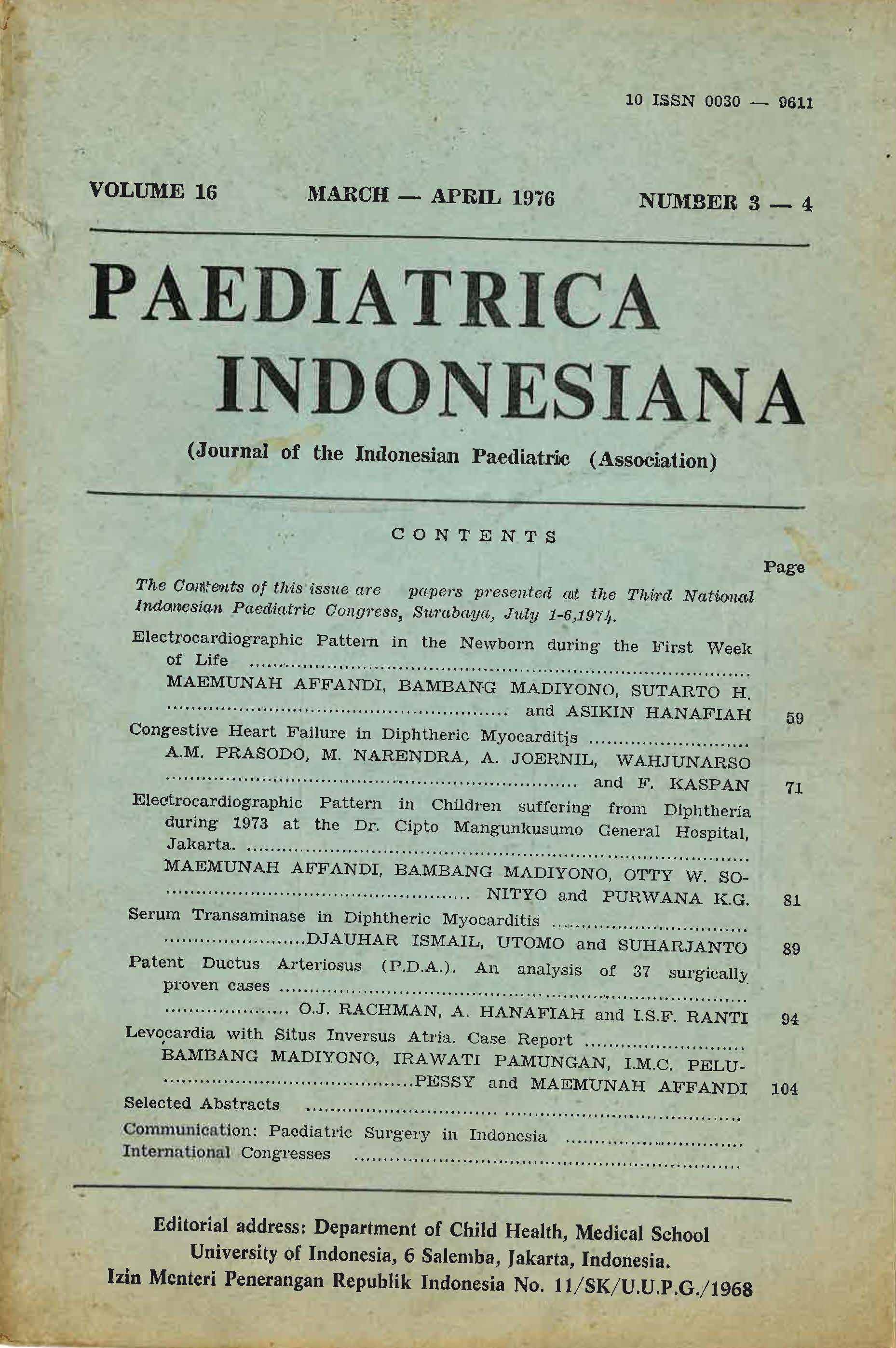Electrocardiographic Pattern in the Newborn During the First Week of Life
Abstract
One hundred and sixteen babies were given electrocardiogram examination on the 1st day until the 7th day of birth as well as the examination at 3 and 6 months.
There were definite changes in the heart rate, P duration, PR interval, T axis, and T wave of the right precordial leads on the 1st day, especially on the 1st hours of birth. These changes may be caused by physiological adjustment after birth and anatomical changes like the closing of foramen ovale and ductus arteriosus. There were changes on the second day and thereafter caused by increased activities of the left side of the heart. Observations were made on ECG examination on fullterm normal babies on the 1st week of birth. Genetic factors should not be ignored (Sutin and Schrire, 1964) as data gathered in this study have shown some differences from data gathered in other studies.
References
2. ALIMURUNG, M.M. and MASSE.L., B.F.: Circulation 13 : 257 (1956).
3. BATTRO, A. and MENDY, J.C. : Precordial leads in children. Arch. Int. Med. 78 : 31 (1946).
4,. COSBY, R.S.; LEVINSON, D.C.; ZINN, W.J.; DIMITROFF, S.P.; and GRIFFITII, G.C.: Congenital heart disease; an analysis of electrocardiographic patterns in 44 patients with elevated right ventricular pressure. Amer. Heart J. 44 : 581 (1952).
5. CRAIGE E. and HARHED, H.S., Jr. : Phonocardiographic and electrocardiographic studies in normal newborn infants. Amer. Heart 3. 65 : 180 (1963).
6. DATEY, K.K. and BARUCHA, P.E.: Electrocardiographic changes in the first week of life. Br. Heart J. 22 :
175 (1960).
7. DAWES, G.S.; MO'IT, J.C. and WIDDICOMBE, J.G.: Closure of the foramen ovale in newborn lambs. J. Physiol. 128 : 384 ( 1955).
8. ELDRIDGE, F.L.; HULTGREN, H.N.; and WIGMORE, M.E.: The physiologic closure of the ductus arteriosus in the newborn infants. J . Clial. Invest. 34 : 987 (1955).
9. EMERY, J.L. and MacDONALD, A.M.: The weight of the ventricles in the later weeks of intra-uterine life. Br. Heart J. 22 : 563 (1960).
10. FURMAN, R.A. and HALLORAN, W.R. : The electrocardiogram in the first 2 months of life, J. Pediatr. 39 : 307 (1951).
11. GOODWIN, J .P.: The electrcardiogram in normal children and in children with right ventricular hypertrophy. Br. Heart J. 14: : 173 (1952).
12. GROEDEL, F.M. and MILLER, M.: Electrocardiographw studies in the newborn. Exp. med. Surg. 2 : 110
(1944).
13. HAFKESBRING, E.M.; DRAWE, C.E.; and ASHMAN, R.: Amer. J. Dis. Child. 53 : 1457 (1937).
14. HAIT, G. and GASUL, B.M.: Evolution and significance of the T wave changes in the normal newborn during the first 3 days of life. Circulation 24 : 949 (1961).
15. LEPESCHKIN, E.: The role of electrolytes in metabolic influences on the electrocardiogram. Fortschr. Kardiol. 2 : 189 (1959).
16. MESSER, A.L.; DONEGAN, C.K.; and and ORGAIN, E.S.: Amer. Heart J. 38 : 732 (1949).
17. MICHAELSSON, M.: Electrocardiographic studies in the healthy newborn. Acta Pediatr. 48 : 108 (1959).
18. RICHMAN, B. and MASTER, A.M : The unipolar chest and extremity lead electrocardiogram in children (newborn to 10 years old). Amer. Heart. J. 41 : 687 (1951).
19. SA VILA.HTI, M. : Acta Med. Scand. 123 : 252 (1946).
20. SCHAFFER, A.J. BURSTEIN, J ; MASCIA, A.V.; BARENBERG, P.L.; and STILLMAN, N.: The unipolar electrocardiogram of the newborn infant. Amer Heart J. 39 : 588 (1950).
21. SCOTT, 0. and FRANKLIN, D.: The electrocadiogram in the normal infant. Br. Heart J. 25 : 411 (1963).
22. SMITH, C.A.: The physiology of the newborn infant. (Thomas, Springfield 1959).
23. SUTIN, G.J. and SCHRIRE, V.: The electrocardiogram in the first 2 days of life; an interracial study. Amer. Heart J. 67 : 749 (1964).
24. TUDBURY, P.B. and ATKINSON, D.W. : The electrocardiograms of 100 normal infants and young children. J. Pediatr. 36 : 466 (1950).
25. WALSH, S.Z.: P wave duration and PR interval during the first week of life. Br. Heart J . 25 : 42 (1963).
26. WALSH, S.Z.: The electrocadriograph during the first week of life. Brit. Heart J. 25 : 784 (1963).
27. WALSH, S.Z.: The S-T segment and T wave during the first week of life. Br. Heart J. 26 : 679 (1964).
28. ZIEGLER, R.F.: Electrocardiographic studies in normal infants and children. (Thomas, Springfield 1951).
29. ZIEGLER, R.F.: The importance of positive T waves in the right precordial electrocardiogram during the first year of life. Amer. Heart J. 52 : 533 (1956).
Copyright (c) 2019 Maemunah Affandi, Bambang Madiyono, Sutarto H., Asikin Hanafiah

This work is licensed under a Creative Commons Attribution-NonCommercial-ShareAlike 4.0 International License.
Authors who publish with this journal agree to the following terms:
Authors retain copyright and grant the journal right of first publication with the work simultaneously licensed under a Creative Commons Attribution License that allows others to share the work with an acknowledgement of the work's authorship and initial publication in this journal.
Authors are able to enter into separate, additional contractual arrangements for the non-exclusive distribution of the journal's published version of the work (e.g., post it to an institutional repository or publish it in a book), with an acknowledgement of its initial publication in this journal.
Published 2019-09-13













